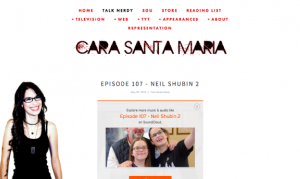Research and Education
Back to Top
|
 |
|
National Portrait Gallery: First Ladies
|
Arts |
|
Lou Henry Hoover may be best known for serving as the nation's first lady from 1929 to 1933, however, she was also a talented linguist who made regular appearances on the newly minted nationwide radio broadcast system and was the first - and only - first lady to speak fluent Mandarin. In this collection from the Smithsonian National Portrait Gallery, readers may view a portrait of Lou Henry Hoover taken in 1929. They may also view portraits of Mary Todd Lincoln, Grace Coolidge, Martha Washington, Michelle Obama, and 39 other first ladies. Each image is accompanied by informative text about the artist or photographer who created the portrait, the year the portrait was made, the dimensions of the original, and other fascinating details. For educators looking for ways to bring to life the first ladies of the United States, this will be an excellent resource. [CNH] |
|





|
|
 |
|
 |
|
National Archives: Teaching with Documents: Japanese Relocation During World War II
|
Social studies |
|
Between 1942 and 1945, thousands of Japanese Americans - regardless of citizenship - were evacuated from their homes and relocated to interment camps across the country, by order of the U.S. Government. This lesson is part of the Teaching with Documents series at the National Archives and offers educators many helpful tools to teach about Executive Order 9066 and the lived experience of Japanese relocation during WWII. Resources include nearly two dozen primary documents, photographs, letters, and other ephemera that may be used to engage students in critical analysis. For instance, one teaching activity of note encourages students to make connections to the First, Fourth, and Fifth Amendments to the Constitution, while a vivid photograph of teenagers standing on the High School Campus at Heart Mountain, Wyoming, reveals what daily life might have been like in the camps. [CNH] |
|





|
|
 |
|
C-SPAN Landmark Cases
|
Social studies |
|
These special programs, which aired on C-SPAN for 90 minutes each night between March 28 and April 9, 2016, bring to life the drama that accompanied some of the most important Supreme Court decisions in American history. Nearly everyone has heard of Brown V. Board of Education, for instance, or Roe V. Wade, but how much does the average student or casual history buff know about 1905's Lochner V. New York, which in overturning a New York law that limited the number of hours a baker could work each week presaged the current "Right to Work" legislation now making its way through state courts. Landmark Cases also unearths the controversies surrounding such influential decisions as Scott V. Sandford (1857), Marbury V. Madison (1803) and Baker V. Carr (1962), among others. Educators looking for ways to liven up their civics lessons will find much to appreciate in these well produced episodes, in which C-SPAN journalists interview historians and other experts in the field of Supreme Court law. [CNH] |
|





|
|
 |
|
NOVA: Interactives Archive
|
Educational Technology |
|
These interactives from the popular PBS science show, NOVA, can get students involved in a wide range of topics, from Anthropology to Technology. Readers may like to scout the site by Interest, which includes such categories as Biology, Chemistry, Disasters, Earth, Exploration, Flight, and half a dozen others. Particular highlights include the Stone Age Toolkit, in which students examine the tools and weapons that humans began to fashion approximately 40,000 years ago, and Design a Parachute, where readers can use the interactive to design a custom-made parachute to help the Mars Exploration Rovers Spirit and Opportunity land safely on the Red Planet. Social Studies, Language Arts, Social Sciences, Biology, and Chemistry teachers will all find excellent material for their classrooms on this PBS-sponsored website. [CNH] |
|





|
|
 |
|
 |
|
History by Era: The Americas to 1620
|
Social studies |
|
The Gilder Lehrman Institute of American History is one of the great repositories of information about American history and culture. The Americas to 1620 exhibit, featured here, explores the world of North America, beginning with the settlements that began between 20,000 BCE and 9,500 BCE. From there, readers may use the interactive timeline to learn about the Hopewell Culture, which flourished in east-central North America between 200 BCE and AD 500, the great Hohokam and Anasazi cultures of the southwest, the Mississippian Culture that flourished through the 1500s, or the Aztecs in the Valley of Mexico, among others. In addition to an excellent timeline, readers will find pithy explanations of lands and peoples, and wonderfully evocative visual images that bring to life the pre-European history of the Americas. [CNH] |
|





|
|
 |
|
MIT BLOSSOMS: Physics Resources
|
Science |
|
MIT BLOSSOMS offers video lessons to enrich the experience of high school students studying a variety of subjects. In addition to the dozens of videos housed in the BLOSSOMS Video Library, readers will also find an excellent assortment of Physics Resources on this page. Here educators and students will find links to enlivening material from around the web. For example Newton's Laws of Motion and Car Physics, takes readers step-by-step through Sir Isaac Newton's revered construction of the three laws of motion. Or, readers might be interested in the 2,000+ physics lesson plans on Share My Lesson. Other links take readers to an interactive dedicated to understanding particles, a site that examines the practical applications of physics, and the University of Colorado's PhET interactive, where students may interface with simulations in physics, chemistry, biology, and earth science. From the resources on this list, educators and students alike are sure to find a great fit for their next physics adventure. [CNH] |
|





|
|























